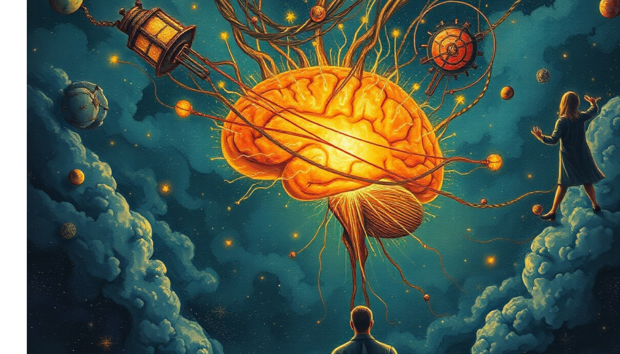Understanding the Science of Dreams
Dreams and the subconscious have long fascinated humanity, serving as a portal to our inner thoughts and emotions. Dreams occur during the REM (Rapid Eye Movement) stage of sleep, a critical period when our brain is highly active. During this time, brain waves resemble those of waking hours, leading to vivid and often surreal experiences. The exact purpose of dreams remains a topic of debate among scientists and psychologists, but several theories attempt to explain their significance.
One prominent theory is that dreams serve as a form of emotional processing. They allow individuals to work through feelings and experiences from their waking life, providing a safe space to confront fears and anxieties. This emotional regulation can be particularly beneficial for mental health, helping to reduce stress and improve emotional resilience.
Another theory posits that dreams play a role in memory consolidation. As we sleep, our brains sift through the day’s events, organizing and integrating information. This process not only strengthens memories but also allows us to make connections between disparate pieces of information, enhancing our problem-solving abilities and creativity.
What Really Is the Subconscious Mind?
The concept of the subconscious mind, as popularized by Sigmund Freud, plays a pivotal role in understanding human psychology. Freud proposed a model of the mind that includes three levels: the conscious, preconscious, and unconscious. The unconscious mind is particularly significant, as it houses repressed memories, desires, and instincts that influence behavior without our awareness.
Freud’s theory suggests that the unconscious mind acts like an iceberg, with most of its content hidden beneath the surface. This hidden part contains thoughts and feelings that are too threatening or socially unacceptable to acknowledge consciously. For instance, repressed desires related to aggression and sexuality reside here, shaping our actions and reactions in subtle ways. Freud believed that these unconscious elements could surface through dreams, slips of the tongue, and neurotic symptoms, offering a glimpse into our deeper psyche.
In Freudian terms, the subconscious mind is not merely a storage space for forgotten memories; it actively influences our behavior and emotional responses. By interpreting dreams and other manifestations of the unconscious, psychoanalysts aim to bring these hidden aspects to light, facilitating greater self-awareness and psychological healing.
The Structure of Freud’s Mind Model
Freud’s topographical model divides the mind into three distinct layers: conscious, preconscious, and unconscious. The conscious mind encompasses thoughts and feelings we are currently aware of—essentially everything we can actively think about at any given moment. In contrast, the preconscious contains memories that are not currently in awareness but can be easily accessed when needed.The unconscious mind is where Freud focused much of his attention. He argued that this layer holds significant emotional weight and influences behavior in ways we often do not recognize.
For example, unresolved childhood conflicts might manifest in adult relationships or behaviors without the individual being aware of their origins. Freud viewed this unconscious influence as crucial to understanding mental health issues.By exploring these layers through techniques such as free association and dream analysis, Freud aimed to uncover hidden motivations and conflicts related to dreams and the subconscious. This process allows individuals to confront their repressed emotions and desires, ultimately leading to personal growth and healing.
Dreams as a Window to the Unconscious
Freud famously regarded dreams as “the royal road to the unconscious.” He believed that dreams provide valuable insights into our hidden thoughts and feelings. In his view, dreams serve as a protective mechanism during sleep, allowing repressed desires to surface in a disguised form. This process involves what Freud termed “dream-work,” which transforms latent content (the hidden meaning) into manifest content (the dream as recalled).
For instance, if someone dreams about losing control while driving, this could symbolize deeper anxieties about life circumstances or personal relationships. By analyzing these symbols within the context of one’s life experiences, individuals can gain clarity about their emotional state and unresolved issues.
Freud also differentiated between two types of content in dreams: manifest content (the storyline) and latent content (the underlying meaning). Understanding this distinction is essential for effective dream interpretation. By deciphering the latent content through analysis, individuals can uncover significant insights into their subconscious motivations and fears.
The Influence of Repression on Behavior
Repression is a central concept in Freud’s theory of the subconscious mind. It refers to the process by which distressing thoughts or memories are pushed out of conscious awareness to protect the individual from anxiety or discomfort. While repression serves a protective function, it can also lead to psychological distress when unresolved issues remain buried beneath the surface.Freud posited that repressed emotions often find alternative expression through dreams or symptoms of neurosis. For example, someone who has experienced trauma may develop anxiety disorders or phobias rooted in repressed memories. These manifestations serve as indicators that unresolved conflicts are at play within the subconscious.
Example of Repression in Dreams
An illustrative example of how repression can surface in dreams involves dreaming about a red dress. Imagine a person who has always felt overshadowed in social situations, struggling with feelings of inadequacy and self-doubt. In their dream, they find themselves wearing a striking red dress, a symbol of confidence and attention. While the vibrant color represents their suppressed desire for recognition and boldness, the dream may also evoke feelings of discomfort or anxiety about standing out. In this case, the red dress serves as a manifestation of the dreamer’s repressed wishes for self-expression and acknowledgment. The dream highlights their internal conflict: while they yearn for visibility and empowerment, they also fear judgment or rejection.
This duality illustrates how repression can shape not only dreams but also waking behavior, as individuals navigate their desires and fears in everyday life.This example of the red dress vividly demonstrates the connection between dreams and the subconscious. The dreamer’s experience reflects deeper emotional struggles that are often hidden from conscious awareness. By analyzing such dreams, individuals can uncover repressed feelings and desires, gaining insight into their subconscious motivations. Ultimately, understanding these dynamics can lead to greater self-awareness and personal growth as they confront the fears that influence their waking lives.
The Legacy of Freud’s Theories About Dreams and The Subsconscious Mind
Freud’s exploration of the subconscious mind has left an indelible mark on psychology and our understanding of human behavior. His theories laid the groundwork for modern psychoanalysis and continue to influence therapeutic practices today. While some aspects of his model have been challenged or refined over time, the fundamental idea that unconscious processes shape our thoughts and actions remains widely accepted.
The ongoing interest in dreams as a window into the subconscious reflects Freud’s lasting legacy. Contemporary psychologists continue to study dream analysis as a means of understanding emotional states and psychological well-being. Furthermore, advances in neuroscience have begun to validate some aspects of Freud’s theories regarding unconscious processes influencing behavior.
By acknowledging the complexities of the subconscious mind, we open ourselves up to deeper self-exploration and understanding—an endeavor that remains relevant in today’s fast-paced world where many emotions often go unexamined.






